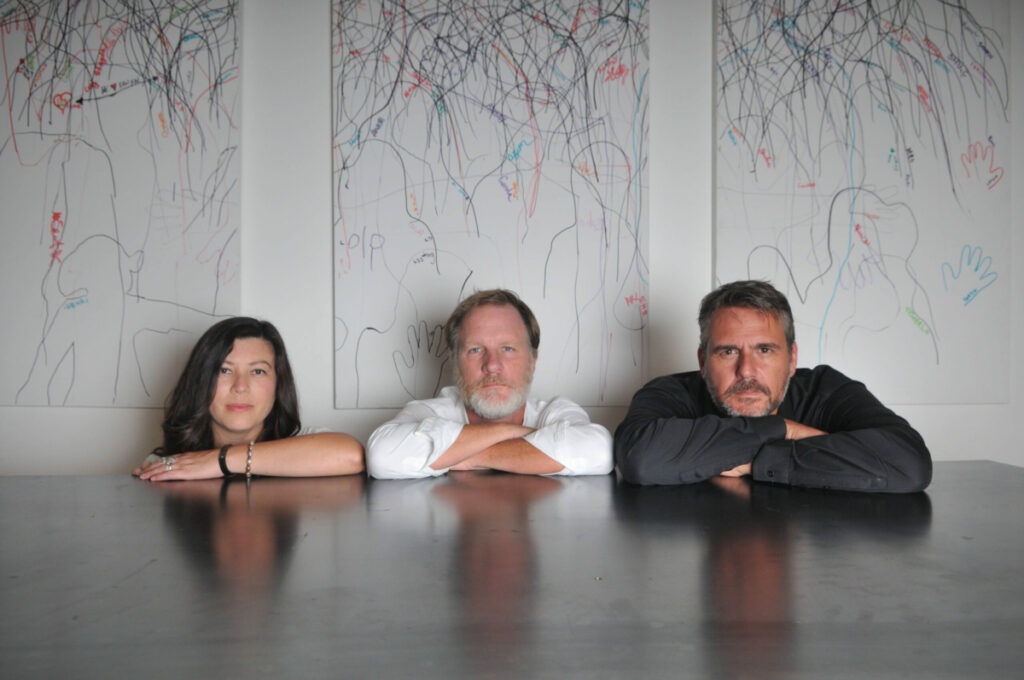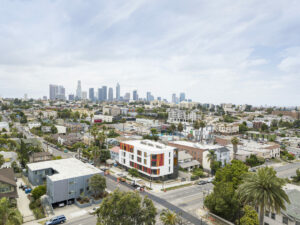Because they work for developers, architects become well-versed in the process of creating buildings. But some successful design studios take on the role of developer.
Koreatown-based firm Andmore Partners, led by Sean Mo and Heagi Kang, two Korean-American architects who met at Southern California Institute of Architecture, bootstrapped some cash so they could be developers of the commercial and multifamily buildings they designed.
The move to become part-time developers was spurred by the frustration of designing projects for clients.
“Some decisions made by them, we couldn’t understand,” Mo said. “So, we decided to do everything by ourselves from A to Z.”
Sometimes there are constant design changes on projects as budgets are adjusted midstream, which called on the architects to water down their designs to meet the revised budgets.
“Architects don’t have the chance to show leadership,” Mo said. “Every design is driven by the developer, and we don’t like that. Maybe there’s a different way.”
Still, the bulk of their work is designing buildings for other developers, and Mo and Kang find the fact that they develop select projects an asset. That’s because they better understand their developer clients’ challenges such as escalating material costs, supply chain delays and city planning obstacles.
Financing test
Mo and Kang turned to the people around them to finance their first project.
“Luckily, some friends of mine are in the medical field – doctors, dentists,” Mo said. “Over beer, I talked to them. I got the loan and then we purchased a small property in K-Town.”
Andmore has assembled a group of 13 small, private investors. Mo and Kang tried working with banks but decided to prioritize private capital.

The firm’s first project was the Mariposa, a seven-unit, 5,900-square-foot complex in Koreatown, which they sold after receiving an unsolicited cash offer.
Their second project, seven units on Kenmore Street in Koreatown, sold while still under construction.
Mo and Kang also created and completed Rampart Lofts, a nine-unit apartment building in Westlake. Their next development, the Monterey Street project in Highland Park, will be a 12-unit, 3,500-square-foot mixed-use building. They are currently experiencing utility delays and project a first-quarter start date next year on the building.
The development experience helps Andmore’s architecture studio side as well.
“We do our own development, and we try to have good design,” Kang said. “It also helps to bring the information to the client.”
When a client’s design for a multifamily development on an 8,000-square foot lot in a historic Los Angeles neighborhood did not receive approval, he turned to Andmore to revise the design and attain the go-ahead from the Wilshire Park Historic Preservation Overlay Zone.
“Development and architecture design have their own roles,” Kang said. “The developer says architects always cause problems because they want to do some designs to spend the money. Architects criticize the developer – they just see the numbers. They all have important value. We try to combine to make a good balance between development and good design.”
Ideal tenants
Mo and Kang have enjoyed the freedom of design that comes with developing their own buildings.
One example is Rampart Lofts, which Andmore designed for their ideal tenants – young professionals working in tech or entertainment. Instead of one-bedroom or two-bedroom apartments, the firm designed studio apartments with two bathrooms.
“A developer would look at us in a strange way – studio apartment with two bathrooms,” Kang said.
The development experience has made them more valuable as architects, they believe.
“We can guide the client who doesn’t have any experience,” Mo said.

Relativity Architects is another successful design studio that has become serious about development. However, in their case, developing property has not been easy. Even though Relativity has tried several times, it has been unable to complete a development.
Founded in 2013 by Tima Bell and Scott Sullivan, Relativity recently formed a development arm, Relativity Architects Development.
“We’ve done a few (projects), but unfortunately, as sometimes developments happen, they’ve flailed out at the time of contract,” Bell said. “We’ve been undercut.”
Bell shared the frustration of trying to take on a development role.
“We get so close, and we do really beautiful architecture to get the development across and we’ve been submarined a few times,” Bell said, regarding potential development deals falling through for different reasons.
Favorable economic conditions inspired Bell and Sullivan to tackle the role of developer.
“Especially when the interest rates were so low, certain forms of development, we felt that we are knowledgeable enough about so many facets, I don’t see why we wouldn’t try to do this,” Bell said.
Bell said there’s a good reason why he wanted to enter the development space.
“Obviously, developers make more money,” Bell said. “Architecture is a service industry. We’re always getting a small percentage of the construction cost.”
Ginna Nguyen, studio director and associate principal at Relativity, added, “That connection between being an architect and a developer is not just the money aspect, but also the ability to use our knowledge and our passion to be on both ends of the development side and kind of curate these spaces and have a part in how cities come together.”
There was a hotel project in Silver Lake. Relativity Architects Development partnered with the owner of a piece of property. The studio did designs for the project and put together the entitlements package.
“When we read the resulting contract, we realized that we had been marginalized from the requested 15 percent to only 5 percent,” Bell said. “So we had to make a decision.”
Despite the financial slight, Relativity decided to move forward with the partnership
“Even then we decided, ‘This is our first venture, we’ll take less,’” Bell said. “Let’s get something under our belt. The cash and experience are only going to help us on the next one. Everything was in place and the gentleman who owned the land dropped out.”
Relativity will pay land-use attorneys and consultants, because as a developer the firm will create a schematic design and entitlement package as well as the budget breakdowns.
So far, Relativity Architects Development has yet to develop a project.
“The land has been pulled out from under us twice, money has been marginalized,” Bell said.
Small-town politics
The other near-development took place in Wisconsin, where Relativity wanted to buy a building the length of a city block to cultivate and curate.
Relativity turned to a local bank in the Wisconsin town to borrow the money to purchase the block. They were ultimately turned down by the bank and told, “You need to have the funds in order to borrow.”
Then came the shocker. “Two months later, the bank bought the building,” Bell said. “We learned about small-town politics very quickly.”
Bell has no regrets over how Relativity has approached these projects.
“We are extremely honest,” Bell said. “We’re transparent. We run a tight ship and we don’t like to hide things from people who are involved in our projects. We feel that merit and integrity carry a long way.”
However, he learned that honesty doesn’t always produce positive results.
“One of the things we’ve learned is that in the development game, unfortunately, that stuff doesn’t really count for a lot,” Bell said. “We’re not changing but we’re definitely a little more careful in what projects we go forward on.”
Relativity is currently considering partnering and co-developing on a proposed equestrian center project called Connecting Compton, a multi-year project that will repurpose a decommissioned landfill.
